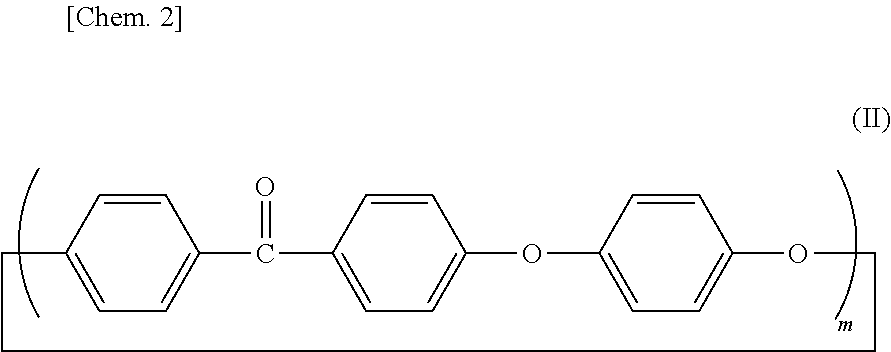Thermoplastic resin composition, and molded product thereof
a technology of thermoplastic resin and composition, which is applied in the direction of organic dyes, etc., can solve the problems of uneven thickness of threads and thread breakage, low thermal stability in the melt state, and difficult thin-film processing
- Summary
- Abstract
- Description
- Claims
- Application Information
AI Technical Summary
Benefits of technology
Problems solved by technology
Method used
Image
Examples
reference example 1
[0141]In an autoclave device with a stirrer, 1.1 kg (5 mol) of 4,4′-difluorobenzophenone, 0.55 kg (5 mol) of hydroquinone, 0.69 kg (5 mol) of anhydrous potassium carbonate and 50 liters of N-methyl-2-pyrrolidone were loaded. The amount of N-methyl-2-pyrrolidone with respect to 1.0 mol of the benzene ring component in the mixture was 3.33 liters. After replacement of the inside of a reaction vessel with nitrogen, the reaction proceeded while the temperature of the reaction vessel was raised to 145° C., was kept at 145° C. for 1 hour, was further raised to 185° C., was kept at 185° C. for 3 hours, was furthermore raised to 250° C. and was kept at 250° C. for 2 hours. After completion of the reaction, the reaction vessel was cooled down to room temperature, and the reaction mixture was obtained.
[0142]The resulting reaction mixture was weighed and was diluted with THF to about 0.1% by weight. A sample for high-performance liquid chromatography analysis was prepared by separating and rem...
reference example 2
[0147]In a four-necked flask equipped with a stirrer, a nitrogen inlet tube, a Dean-Stark apparatus, a condenser tube and a thermometer, 22.5 g (103 mmol) of 4,4′-difluorobenzophenone, 11.0 g (100 mmol) of hydroquinone and 49 g of diphenyl sulfone were loaded. The amount of diphenyl sulfone with respect to 1.0 mol of the benzene ring component in the mixture was about 0.16 liters. A substantially colorless solution was obtained by heating the mixture to 140° C. under nitrogen flow. At this temperature, 10.6 g (100 mmol) of anhydrous sodium carbonate and 0.28 g (2 mmol) of anhydrous potassium carbonate were added to the solution. The temperature of the mixture was raised to 200° C., was kept at 200° C. for 1 hour, was further raised to 250° C., was kept at 250° C. for 1 hour, was further raised to 315° C. and was kept at 315° C. for 2 hours.
[0148]About 0.2 g of the resulting reaction mixture was weighed, was diluted with about 4.5 g of THF. A sample for high-performance liquid chroma...
examples 1 to 19
, Comparative Examples 1 to 24
[0157]After the respective components were dry-blended at the fractions specified in Tables 2 to 4, the mixture was fed from an extruder main feeder. The mixture was melt-kneaded at the screw rotation speed of 200 rpm in a twin-screw extruder TEX 30 manufactured by the Japan Steel Works, LTD. at the set cylinder temperature in Tables. The guts ejected from a die were immediately cooled down in a water bath and were cut by a strand cutter to pellets. The pellets obtained in Examples 7, 8, 12, 16 and 17 and Comparative Examples 6 to 9, 16, 17, 21 and 22 were vacuum-dried at 80° C. for 12 hours and were then evaluated as described below. The other pellets were dried with hot air at 120° C. for 5 hours and were then evaluated as described below.
PUM
| Property | Measurement | Unit |
|---|---|---|
| melting point | aaaaa | aaaaa |
| melting point | aaaaa | aaaaa |
| melting point | aaaaa | aaaaa |
Abstract
Description
Claims
Application Information
 Login to View More
Login to View More - R&D
- Intellectual Property
- Life Sciences
- Materials
- Tech Scout
- Unparalleled Data Quality
- Higher Quality Content
- 60% Fewer Hallucinations
Browse by: Latest US Patents, China's latest patents, Technical Efficacy Thesaurus, Application Domain, Technology Topic, Popular Technical Reports.
© 2025 PatSnap. All rights reserved.Legal|Privacy policy|Modern Slavery Act Transparency Statement|Sitemap|About US| Contact US: help@patsnap.com



